Communications, namely telecoms and media, are an exciting sector to explore, since they're how we all stay connected to each other. Plus, they can provide you with a steady stream of income and potential growth through dividends.
In this article, we'll discuss how to invest in communication stocks and what considerations to take into account before committing your capital.
Overview of the Communication Sector
The communications industry is an ever-evolving sector due to advances in technology and the way consumers communicate and consume media. Communication stocks generally fall under two categories: Telecom (wireless) and media (cable/satellite).
Communication stocks are typically shares of companies that provide these services. You can either buy individual stocks, mutual funds or exchange-traded funds (ETFs) tied to these industries.
Why Invest in Communication Stocks?
Investing in communications companies is a smart way to diversify your portfolio across multiple industries and capitalize on both short-term growth opportunities and long-term stability. Communications stocks are sometimes considered higher risk than other types of investments due to their sensitivity to market conditions. But you can mitigate that by researching the industry thoroughly and making informed decisions.
When choosing which stock, ETF or mutual fund to invest in, consider current market conditions, the company's fundamentals and its yield, as well as future growth prospects. Communication companies often have strong competitive advantages due to high barriers to entry, like access to government-regulated wireless spectrum or exclusive content deals. This can lead to stable revenue and cash flow, allowing the companies to pay consistent dividends.
You can then calculate your reinvestment using the MarketBeat dividend calculator.
4 Ways to Invest in the Communication Sector
There are many ways to invest in the communications sector, depending on your risk tolerance and investing goals. Some of the most popular options include:
- Individual stocks: Investing in communication stocks can provide you with access to strong companies with a competitive advantage. However, their performance can be affected by market conditions and industry trends.
- ETFs: ETFs are funds that track a basket of global communication stocks, such as telecom, media and internet companies, like iShares Global Comm Services ETF NYSEARCA: IXP. They trade on stock exchanges. With ETFs, you can diversify your investments without having to pick individual stocks.
- Mutual funds: Mutual funds let you passively invest in professionally managed portfolios of securities, including communication stocks.
- Bonds: Although less common, investing in communication bonds can also be an option. These are debt securities issued by communication companies, which provide a fixed rate of return until the bond matures. The risk of investing in bonds is typically lower than with certain types of stocks, but the potential returns are also lower.
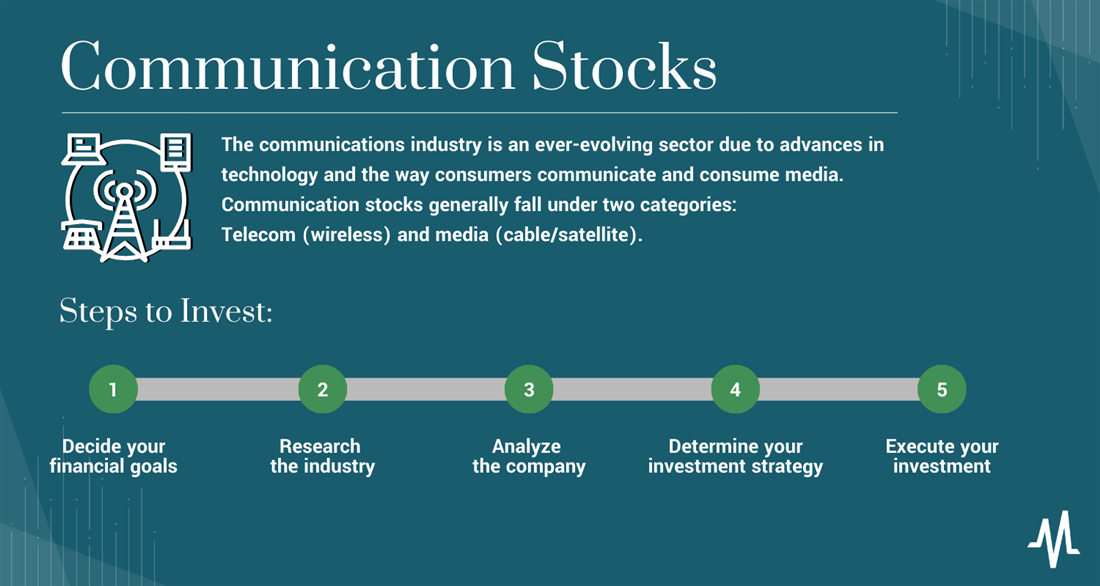
Wired Telecommunications Carriers
Wired telecommunications carriers are companies that own and operate the infrastructure for wired phone lines, internet access and television service. These companies traditionally own physical infrastructure like phone wires or fiber-optic cables.
Examples include AT&T Inc. NYSE: T, Verizon Communications Inc. NYSE: VZ, Comcast Corporation NASDAQ: CMCSK and Charter Communications NASDAQ: CHTR. Investing usually involves buying shares of a company’s stock and holding onto them long-term.
Many wired telecoms have relatively steady businesses that tend to appreciate over time, and some pay dividends, which can provide you with a regular income while they wait for their investments to mature. For example, we'll look at AT&T. Visit the company's stock page on MarketBeat. There, you can not only view the current share price but the market cap, 52-week range and dividend yield in the upper right-hand corner.
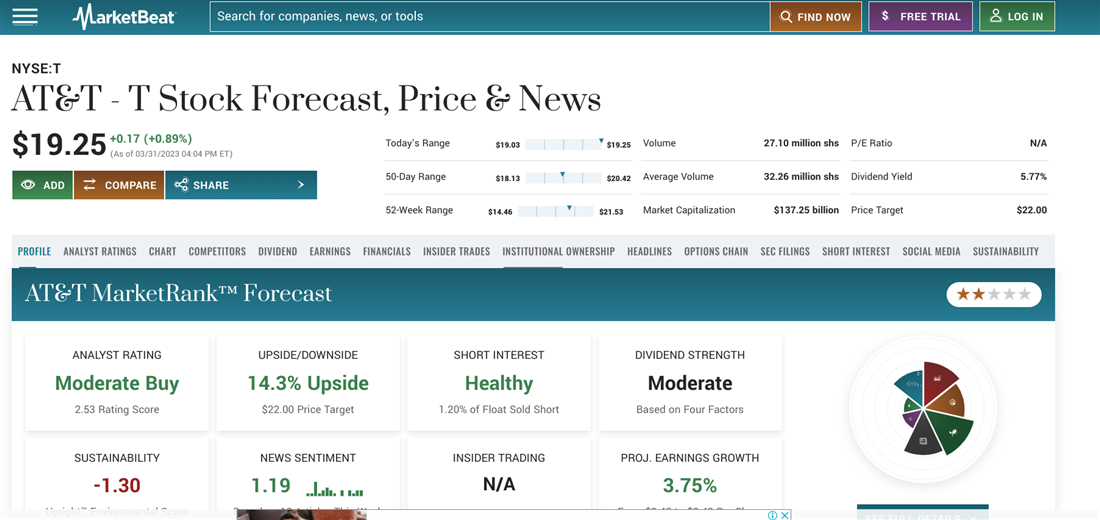
To do this, click on "competitors."
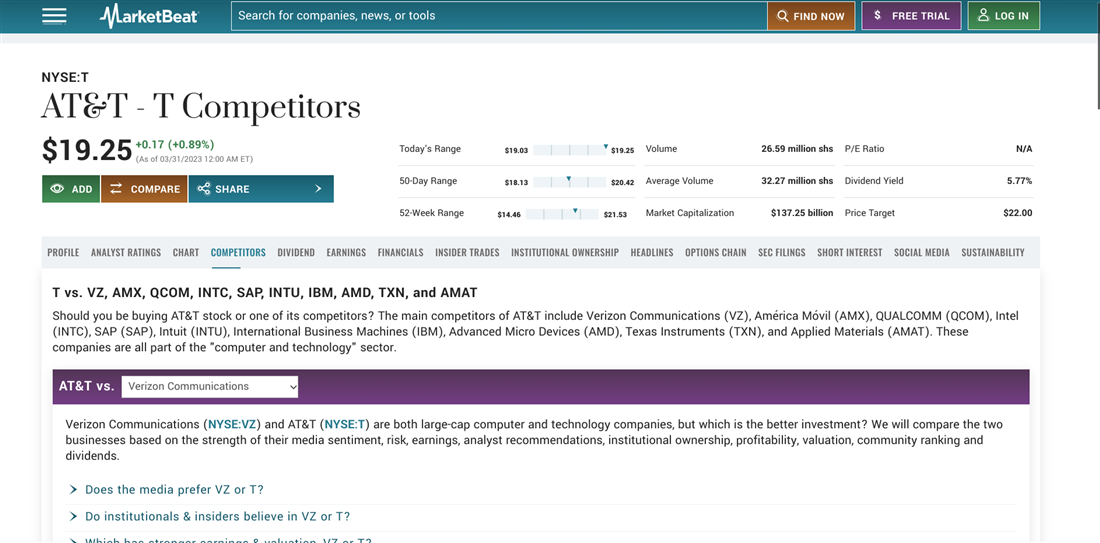
News stories can help you evaluate its customer base size, growth prospects and competitive environment. Also look at how much spectrum the company holds. These are the invisible radio frequencies that wireless signals travel over, a key asset for the best telecom stocks. For example, in October 2022, AT&T announced that its mid-band 5G spectrum now covers 100 million people.
You can also search MarketBeat for news that assesses the company's plans for 5G technology rollout. Consider the competitive landscape. Look at the news on "related companies" (below left). Remember, new entrants may be able to undercut current providers on pricing or offer better service plans for customers.
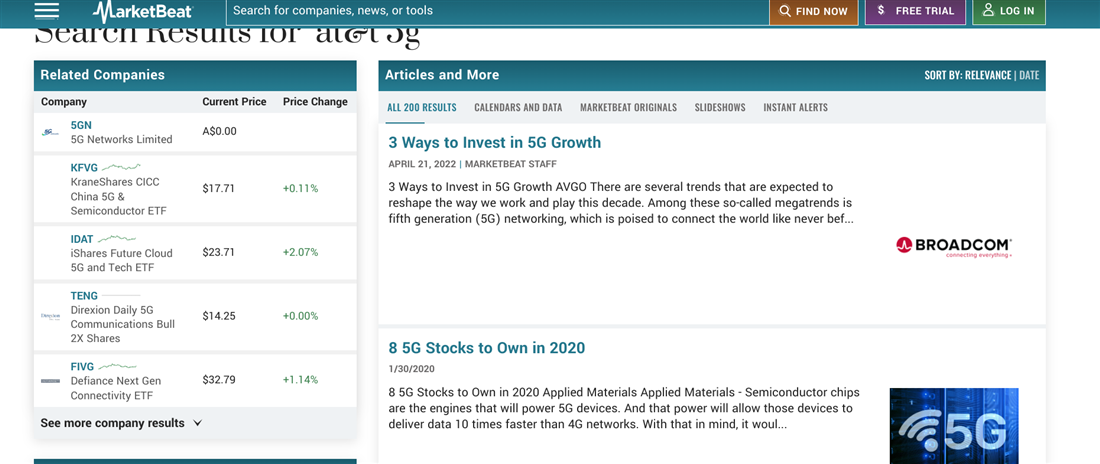
Wireless Telecommunications Carriers
Wireless telecommunications carriers provide mobile phone and data services over cellular networks. These companies often have exclusive access to government-allocated spectrum that makes them hard to compete with. Examples include T-Mobile US NYSE: TMUS and Verizon. Investing in wireless telecoms can provide an opportunity for growth in the long run, as more people rely on mobile devices. Let's take T-Mobile as an example. When you choose a wireless stock, you'll want to assess its debt levels, income and revenue growth. Click on "financials" on its stock page to see this information.
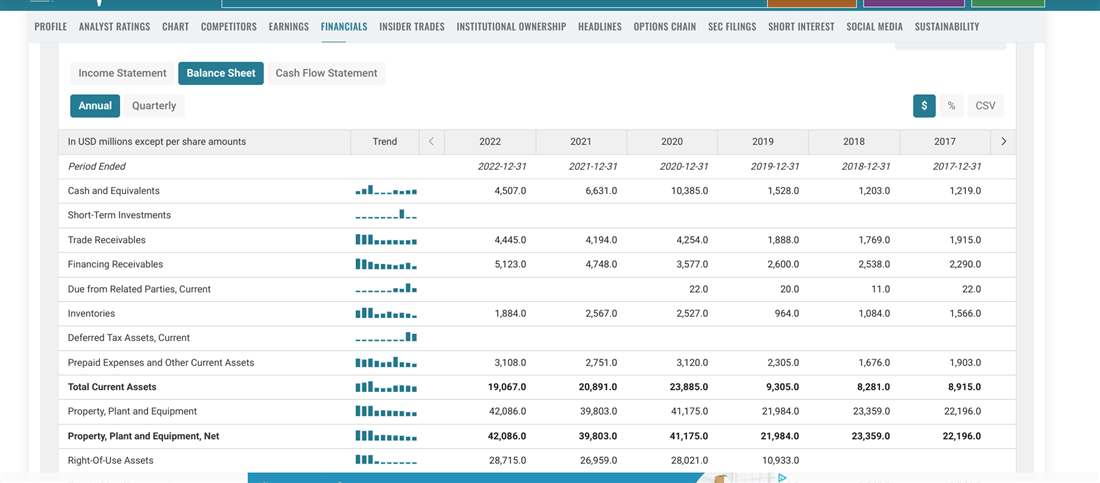
Assess the company's dividend yields. In this case, we can see that T-Mobile does not pay dividends (listed as N/A on the upper right of its stock page).
Also assess a telecom's network coverage and customer base. By searching for T-Mobile, we can see, for example, a news story that says that in February 2023, T-Mobile's 5G network covered approximately 98% of Americans, with two-thirds of its network traffic on 5G. It also increased its customer base for the previous three quarters.
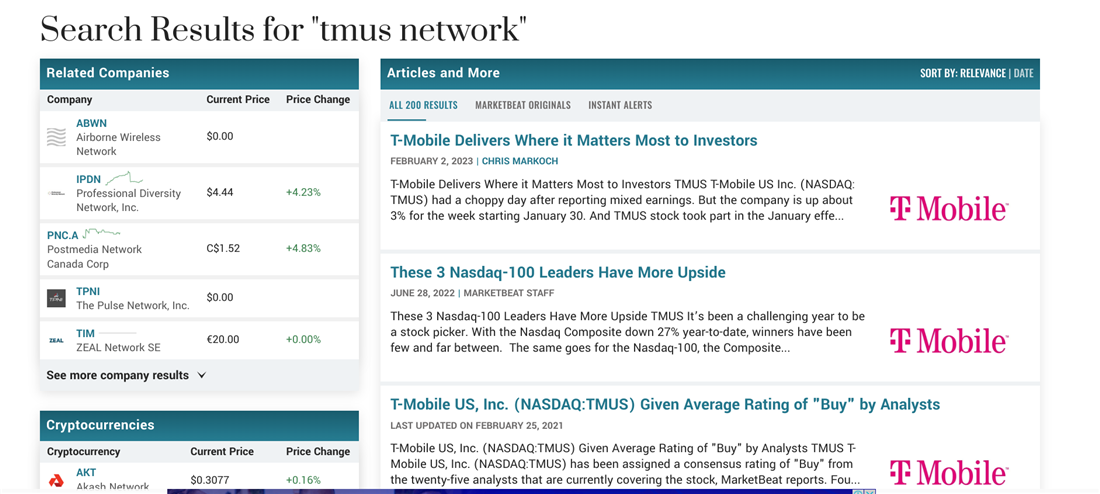
Satellite Communications
Satellite communications companies use satellites to transmit data and video signals, often to provide direct-to-home television services and internet access. Examples include Dish Network Corp. NASDAQ: DISH and DirecTV NASDAQ: DTV. When evaluating a satellite company stock, understand the industry landscape, including competitors who may offer better or cheaper services. In the instance of Dish Network, for example, we can find those by clicking "competitors" on the stock page and clicking through to the company you want more information about.
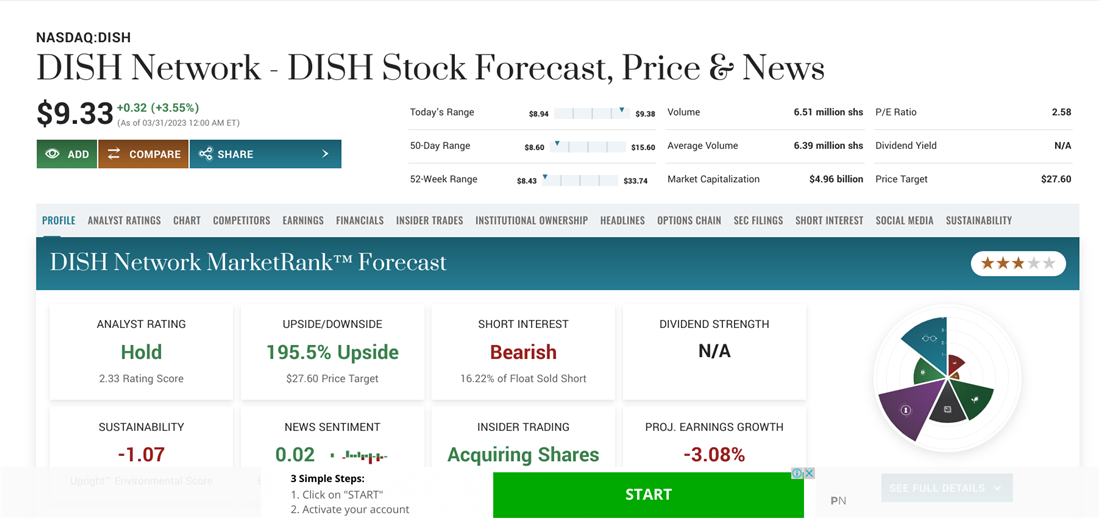
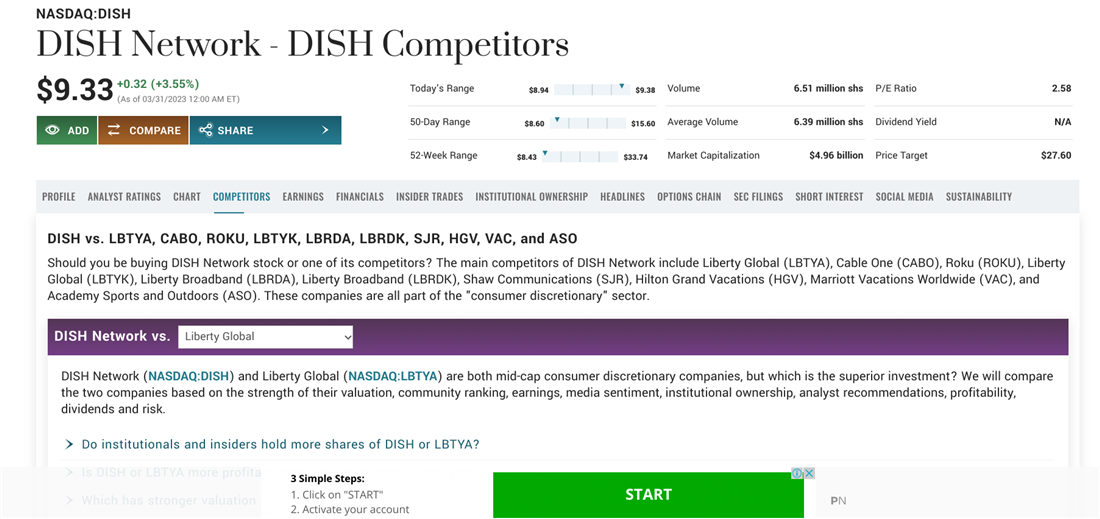
Evaluate the company's debt load by clicking "financials."
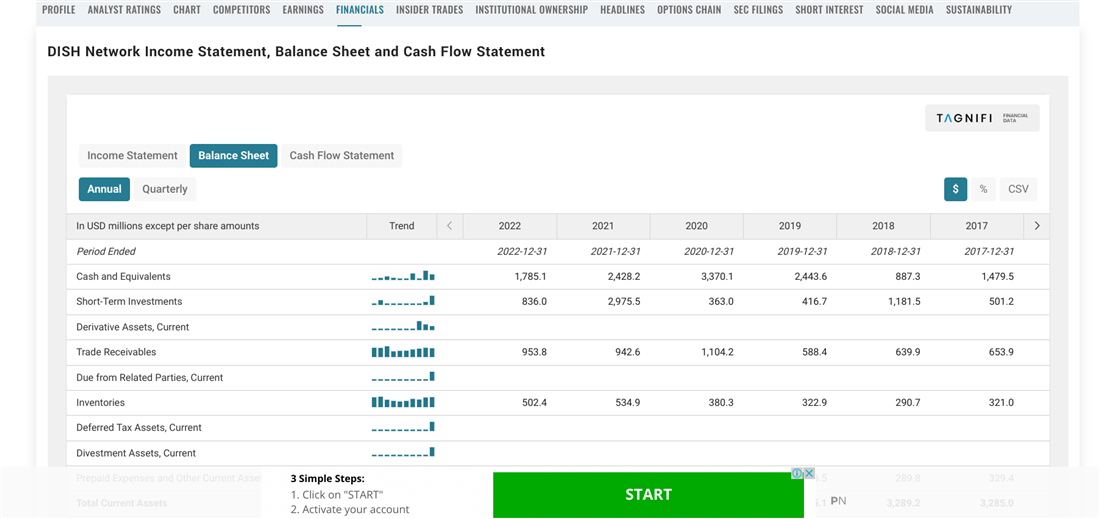
By searching for company news, you can view its customer and pricing strategy, base size and growth prospects. For instance, in November 2021, we found that the market reacted badly to Dish Network's plans to fund its $4 billion purchase of new wireless spectrum assets by issuing the same amount in debt.
It's also worth it to consider the technology used by the company (such as spot beams or addressable advertising), and current trends, such as increasing demand for high-definition programming.
Media stocks are shares of companies that own and operate broadcast networks, cable and satellite TV channels, newspaper and magazine publishers, streaming services, games and digital advertising firms. Media and video game stocks on MarketBeat, such as The Walt Disney Company NYSE: DIS, ViacomCBS Inc. NASDAQ: VIACA and Fox Corp. NASDAQ: FOX, which provide you with exposure to an industry that is entertaining, fast-paced and has long-term potential for growth. When investing in a company like Fox, for instance, assess the company's dividend yield (top right), then take a look at its debt load and cash flow by clicking on "financials."

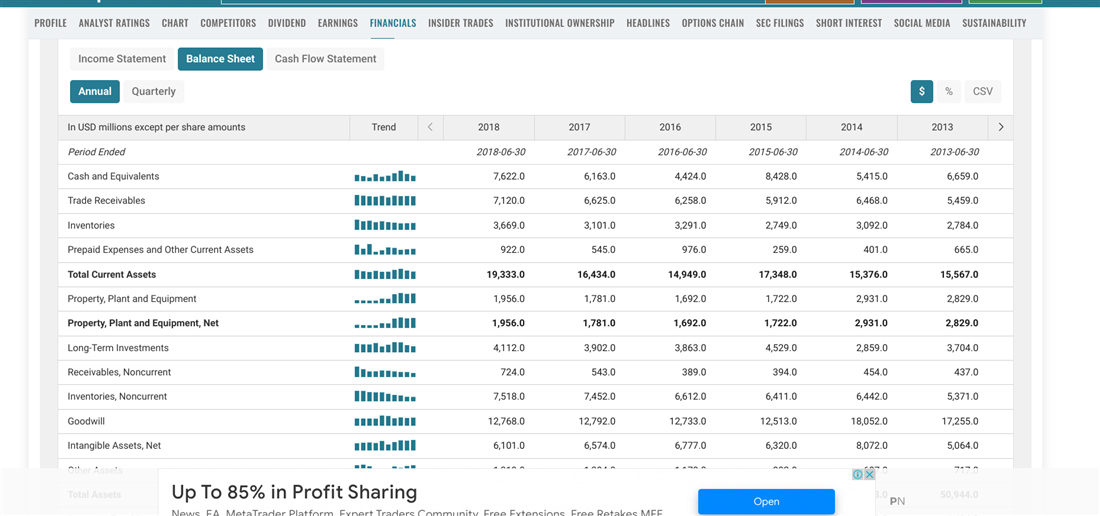
Look at the size of its customer base and whether it is growing or shrinking. Consider any strategic investments it has made in technology or content providers that may give it a competitive edge in the future. For instance, a search of MarketBeat for news about Fox found that in April 2021, it announced that it had built its Fox Bet free-to-play membership to over four million players.
How to Invest in Communication Stocks
Investing in communication sector stocks can be a great way to gain exposure to the rapidly changing and growing tech industry. Here's a step-by-step guide.
Step 1: Decide your financial goals.
Before investing in communication stocks, determine your investment goals and risk tolerance. Are you looking for long-term growth, short-term gains, or regular dividend income? How much risk are you willing to take on? Decide which type of communication stocks you would like to invest in — wired telecommunications carriers, wireless telecommunications carriers or satellite communications companies.
If you're looking for dividend income, then a wired telecom carrier may be the best option. If you're looking for potential growth and appreciation in share value, then a wireless or satellite communications company might be more attractive. On MarketBeat, you can click on "stock lists" and then "telecom stocks" to view a complete list of the best low-priced stocks on MarketBeat and compare them.
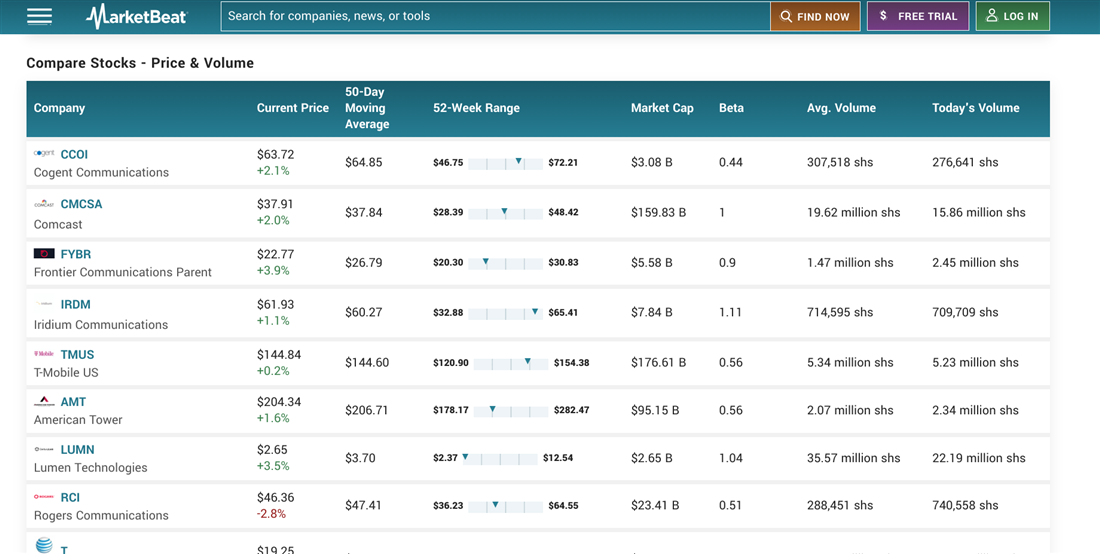
Step 2: Research the industry.
Once you have decided on the type of communication stock to invest in, you need to research the industry. This involves looking into the companies that operate in the industry, their competitors and market trends. You can do this by reading industry reports, news articles and financial statements of the companies you are interested in. On MarketBeat, for instance, you can compare stocks on MarketBeat and evaluate the performance of AT&T, Verizon and Charter Communications stocks for the past year by clicking on "compare stocks" and entering those symbols.
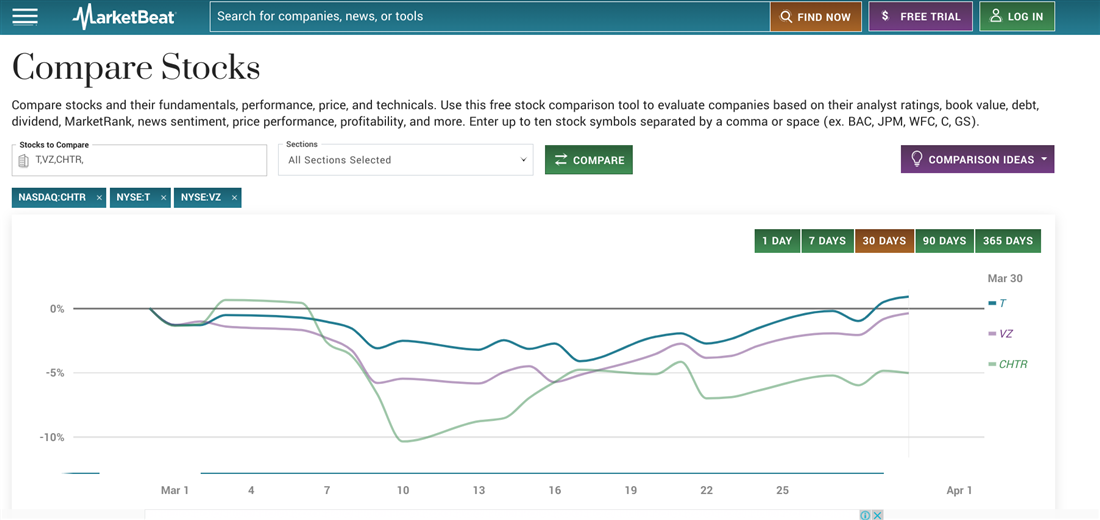
Step 3: Analyze the company.
After researching the industry, it's time to analyze the company you are interested in. Say you chose Verizon. On its stock page, look at the company's financial statements, including revenue, earnings and cash flow. Evaluate the company's debt level and dividend yield. You can also look at analyst reports and ratings to see what the market thinks of the company.

Step 4: Determine your investment strategy.
Once you have analyzed the company, it's time to determine your investment strategy. This involves deciding how much money you want to invest, when to buy and sell the stock and what your expected return on investment will be. You can also decide whether to invest in individual stocks or global ETFs — like iShares Global Comm Services ETF NYSEARCA: IXP, below — that are tied to the communication industry, by viewing the share price, the 52-week range and the market cap (upper right).
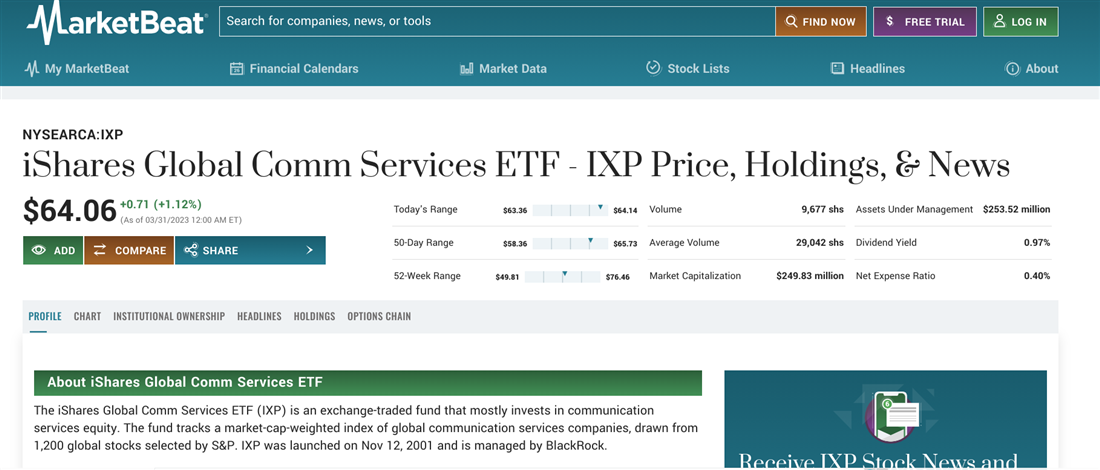
Step 5: Execute your investment.
After deciding on your investment strategy, it's time to invest. You can do this by opening a brokerage account, depositing funds, and placing a buy order for the stock or ETF you want to invest in. Remember to monitor your investment and evaluate whether it is meeting your expectations.
Step 6: Monitor the investment.
After you have made your investment, monitor it regularly. Keep an eye on the company's financials, its industry trends and any news or events that could impact its stock price. In the case of Verizon, for instance, you can search MarketBeat for news headlines related to that stock.

Pros and Cons of Investing in Communication Stocks
Investing in communication stocks has its pros and cons, just like any other type of investment. Here are some of the key advantages and disadvantages to consider:
Pros
Below are some of the main pros of investing in communication stocks:
- Potential for high growth: As technology continues to evolve and society becomes more reliant on communication services, there is potential for high growth. Communication stocks can provide you with an opportunity to capitalize on strong market trends and make a solid return on investment.
- Strong competitive advantages: Many communication companies have strong competitive advantages due to high barriers to entry, such as exclusive access to government-regulated wireless spectrum or exclusive content deals.
- Diversification: By investing in communication stocks, you can diversify your portfolio and reduce your overall risk. Communication stocks tend to be less volatile than other types of investments, so they can provide a stable source of income even when markets are down or uncertain.
- Attractive valuations: Many communication stocks are currently trading at attractive valuations, making them a good option if you're looking for long-term investments with low risk and good returns. Additionally, many communication companies pay dividends. This can help boost your returns over time.
Cons
On the other hand, there are some cons:
- Sensitivity to market conditions: Communication stocks can be sensitive to market conditions and economic downturns, making them riskier than other types of investments.
- Disruptive technologies: Video conferencing, social media and messaging apps can pose a threat to traditional communication companies and their stock prices if they're unable to adapt quickly enough to changing trends. Monitor these new technologies closely.
- Regulatory risks: Communication companies are often subject to heavy regulation and government oversight. Regulations on topics such as net neutrality or data privacy can create additional costs or reduce demand. Research the current regulatory environment before making any investments.
- Competitive landscape: New entrants to the landscape can emerge at any time, disrupting the market. Established companies have to constantly innovate to stay ahead. Investing in a company that has strong competitive advantages could help protect against these potential losses.
Future of Communication Stock Investing
The future of communication stock investing will probably be shaped by the rise of digital technologies and data-driven innovation, in everything from 5G technology to cloud computing solutions. Consumer preferences — from which TV shows they consume to how they communicate with friends and family — change all the time. This will lead to greater demand for services from established players and new entrants. For you as an investor, there will be opportunities to capitalize on the growth in the sector.
Communications Investments: Keeping the Lines Open
Investing in communication stocks is an attractive option if you're looking to grow your portfolio and get involved in a rapidly-evolving industry. With careful research and a well-thought-out strategy, you can take advantage of opportunities while managing risk. As technology advances and consumers demand more, communication stocks are sure to remain a viable option.
FAQs
You now know the basics of how to invest in communication services stocks, but there are probably things you're still wondering about. We tackle the most common questions about this sector below.
What is the best communication stock to buy?
There is no one-size-fits-all answer. While there are many quality companies in the communication sector, there is no single "best" stock. The best communication stocks for you depend on your investment objectives and risk tolerance, as well as the performance of different stocks in the sector. Perform research and consult a financial advisor before deciding.
What industries are in the communication sector?
The communication sector covers telecommunications and media companies that provide services like mobile phone networks, cable and satellite TV, radio broadcasting and internet and streaming services. The sector also includes networking equipment makers, fiber optics providers and satellite companies. Cloud computing solutions are sometimes also considered part of the communication sector.
What are communication services sector stocks?
Communication services sector stocks are issued by companies that provide communication services. These stocks can include telecommunications, media and technology companies, including mobile phone networks, cable and satellite TV, radio broadcasting and internet and streaming services, as well as makers of equipment used by this sector.
Before you make your next trade, you'll want to hear this.
MarketBeat keeps track of Wall Street's top-rated and best performing research analysts and the stocks they recommend to their clients on a daily basis.
They believe these five stocks are the five best companies for investors to buy now...